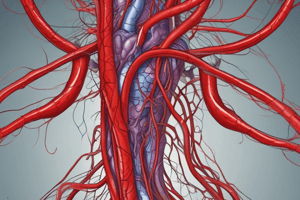Podcast
Questions and Answers
This question relates to blood vessels.
Describe arteries, veins, capillaries, and lymphatic trunks. Include elements that relate to both the structure and the function of each vessel type. (4 marks)
This question relates to blood vessels.
Describe arteries, veins, capillaries, and lymphatic trunks. Include elements that relate to both the structure and the function of each vessel type. (4 marks)
This question relates to the oxygen dissociation curve and has two parts:
- Describe the shape of the oxygen dissociation curve and explain why this shape of the curve is advantageous. (3 marks)
- When you begin exercising there are factors that cause the oxygen dissociation curve to shift to the right. This has an advantageous affect when blood is delivering oxygen to the tissues. Briefly state why it is advantageous to have this curve shift to the right. (1 mark)
This question relates to the oxygen dissociation curve and has two parts:
- Describe the shape of the oxygen dissociation curve and explain why this shape of the curve is advantageous. (3 marks)
- When you begin exercising there are factors that cause the oxygen dissociation curve to shift to the right. This has an advantageous affect when blood is delivering oxygen to the tissues. Briefly state why it is advantageous to have this curve shift to the right. (1 mark)
This question relates to the sympathetic nervous system and its influence on the heart and respiratory system.
During exercise, the sympathetic nervous system (SNS) is stimulated. Identify one element of the heart and one element in the respiratory system affected by increased SNS activity. For each structure:
- Describe how the SNS will alter its function. (2 marks total)
- Explain how this change will be beneficial in exercise. (2 marks total)
This question relates to the sympathetic nervous system and its influence on the heart and respiratory system.
During exercise, the sympathetic nervous system (SNS) is stimulated. Identify one element of the heart and one element in the respiratory system affected by increased SNS activity. For each structure:
- Describe how the SNS will alter its function. (2 marks total)
- Explain how this change will be beneficial in exercise. (2 marks total)



